
Back when I was a full-time remodeler (1983 – 1991), one of my older brothers, Izzy, taught me how to lay ceramic tile. I really liked the combination of physical work and craft, and the beautiful finished result. My brother and I agreed that it seemed out of whack to lay color-fast, durable, water-impermeable tiles and then surround each one with porous, easily-stained, grout. Yeah, the latex-based cement grouts are easier to work with and can be sealed once they have cured, but it seemed like most of our work with this product—and everyone else’s—had dirty, cracked, grout lines down the road, especially in high stress areas like mudrooms, kitchen counters, and showers.
So we tried epoxy grout from Mapei. Anyone who has used two-part epoxy grout, even the newer versions with detergents in the formula, knows how difficult they can be to work with: the short pot-life means you have to really keep to a pace and you do not want to have to try to remove grout film that has even partially set on the surface of tiles. Epoxy grout is a pain for installers. The tradeoff is that it is way better for your clients. It is strong, nearly stain-proof, and yet it remains flexible.
A 2003 tile counter with epoxy grout
With that knowledge and experience in mind, when we remodeled our kitchen, I used epoxy grout for the two tile counters and backsplashes at the sink and side cabinets.

Here is a photo taken Saturday, Sept 28 2019, 16 years after installation, of the sink countertop, which sees a lot of water and food waste:
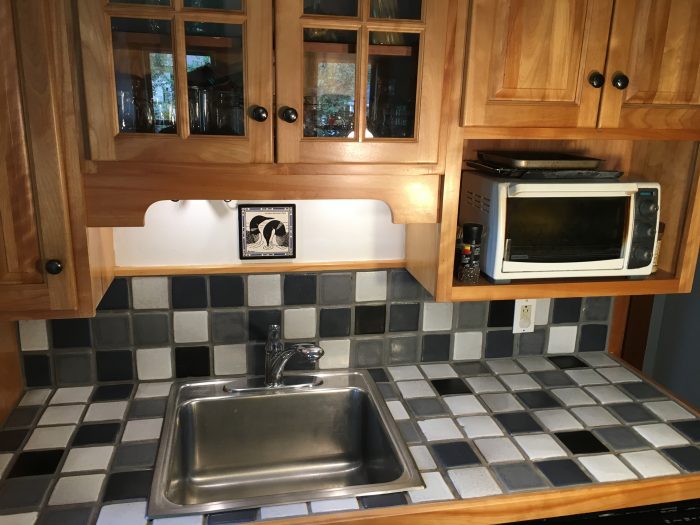
And of the side counter that sees little to no water or contaminants:
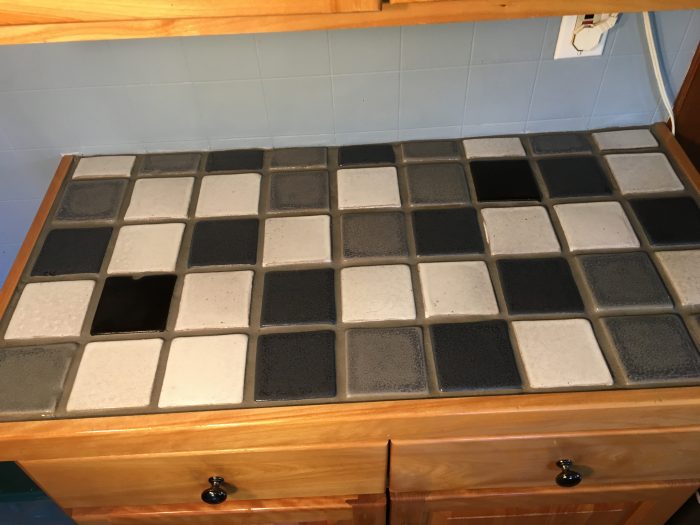
And here is a close-up of the right hand side of the sink:
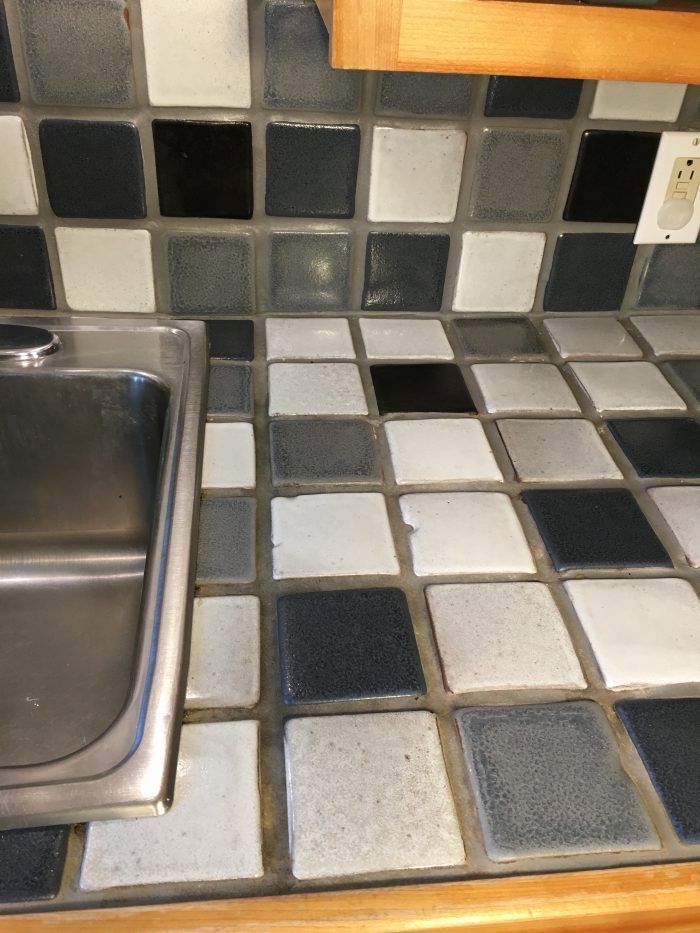
If you look carefully and compare the grout lines just to the right of the metal sink, especially compared to the grout lines in the backsplash, there is some darker discoloration right along the sink and some light almost white spots in the grout just to the right of the 2nd full course of tiles. There’s more on this in the closing section of this blog.
A 2011 experiment with polyurethane grout
In part because of the epoxy grout staining around our kitchen sink, I went looking for a different grout to use when I tiled our downstairs shower stall and floor in 2011. Here’s a shot of the shower stall:
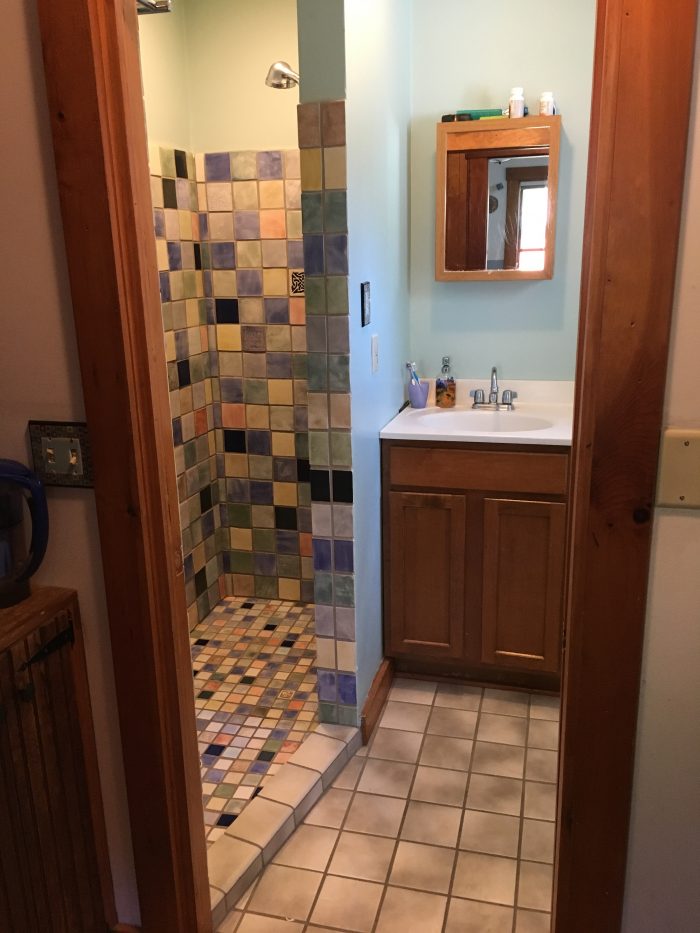
The owner of a local flooring store who was doing a lot of ceramic tile work in his own home strongly recommended a polyurethane grout, Bostik Quartzlock2. He swore that this grout had all of the advantages of epoxy grout (durability, color-fastness, stain-resistance) without the installation challenges: polyurethane grout is a one-part mix and has really long pot-life and does not bond to the tile surface if you leave any grout film for an extended period of time.
I like the way that polyurethane sealants perform, so I decided to give the Bostik grout a try. I carefully read and followed the installation directions, in no small part because the flooring store owner warned me that the polyurethane grout works and tools differently than either standard latex-modified cement or epoxy grout.
Here are current pictures of the polyurethane grout in our downstairs shower:
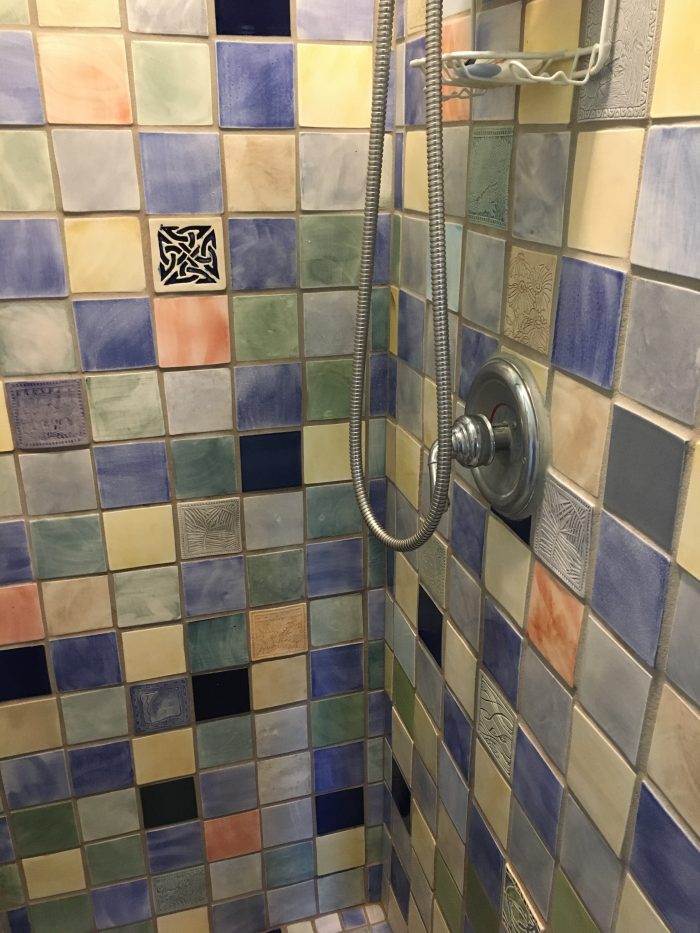
And the downstairs bath floor:
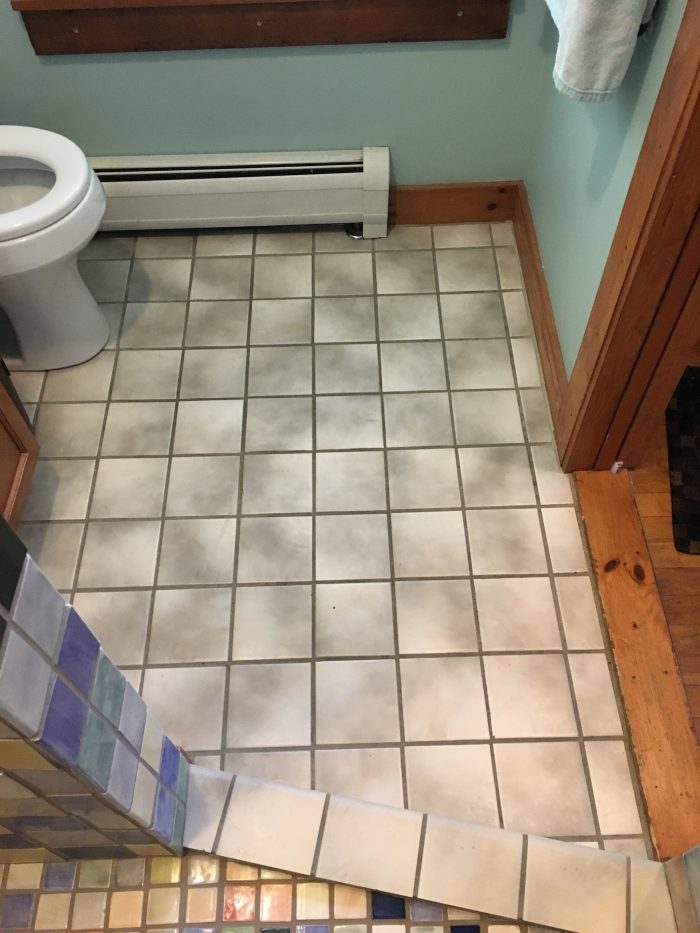
For me, the polyurethane grout was much easier to install than epoxy grout and seems to be just as durable and stain-resistant.
So why isn’t polyurethane grout more popular?
I went to three local flooring retailers looking for information for this blog and not one of them could tell me of a single tile job that used polyurethane grout. Two stated that they can’t even get local installers to use the better-known epoxy grout, much less polyurethane. One retailer told me, “It’s just too much harder to install than latex-modified cement grouts and too expensive. The only time our installers use it—and not without a lot of groaning—is when it’s specced on commercial jobs.”
When I told both retailers how and why we got clients to use epoxy grout—we told our clients that if they could afford ceramic tile, they could afford epoxy grout. And we asked, “You know how ugly the grout is on your current tile floors?” This stuff is durable and does not stain, we told them. The retailers both said: “Hey, that’s a great way to sell it!”
Cleaning epoxy and polyurethane grout
Back to my kitchen and downstairs bathroom grout…neither has proven to be completely stain-proof, despite performing quite well. Wondering how they would clean up, I did some experimenting.
The epoxy grout discoloration to the right of our kitchen sink is quite different than spots on our shower stall polyurethane grout. And I think I might know why after reading this tech sheet on tile in commercial kitchens from Mapei. The oleic acid in fats along with sustained contact with the grout is especially challenging, and something we were not aware of.
In any event, I decided to do a bit of testing, treating both the kitchen sink epoxy grout discoloration and polyurethane black spots with two different cleaners—Soft Scrub, as recommended by Bostik—and my own idea—OxyClean MaxForce stain remover. I know that this cleaner is targeted for fabrics, but it has worked really well for us in removing stains without damaging the substrate on more than just clothes.
In each case, I applied the Soft Scrub and OxyClean generously to three different places as shown below, leaving the cleaners to sit for 15 minutes before scrubbing each with a toothbrush, wiping clear, cleaning and rinsing with water, and then drying with a hair dryer.
Here are the sequence photos, in each case the two cleaners were separated by green masking tape, which also meant there was a spot between the two cleaners that did not get any treatment.
Kitchen sink cleaners applied:
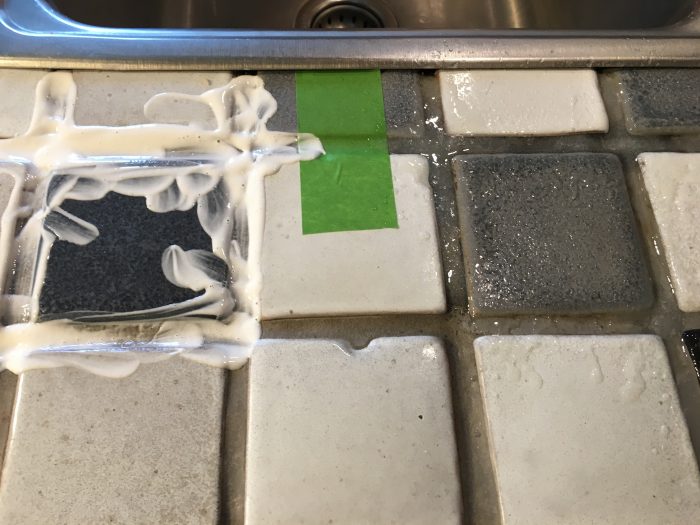
Kitchen sink cleaners scrubbed, wiped, rinsed, and dried:
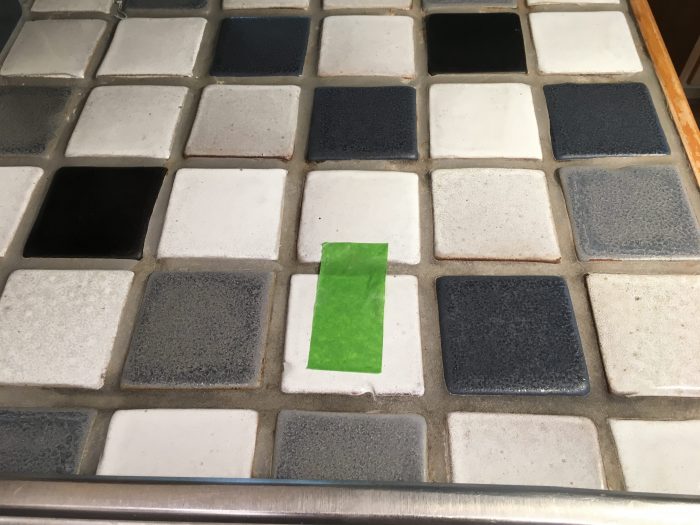
Shower floor showing black spots:
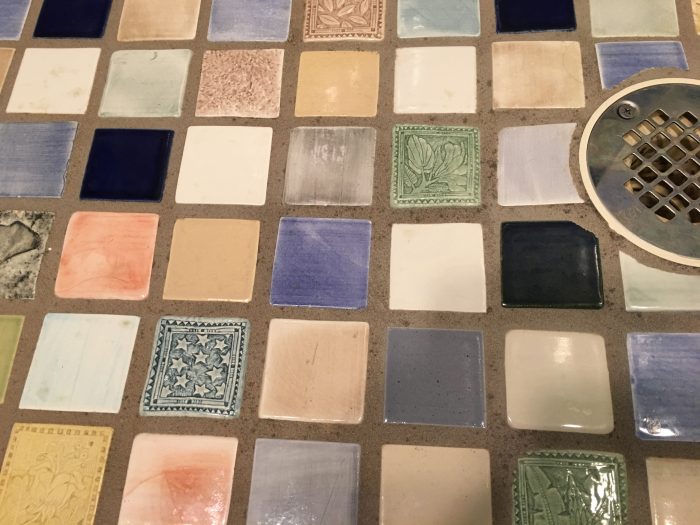
Shower floor with cleaners applied:
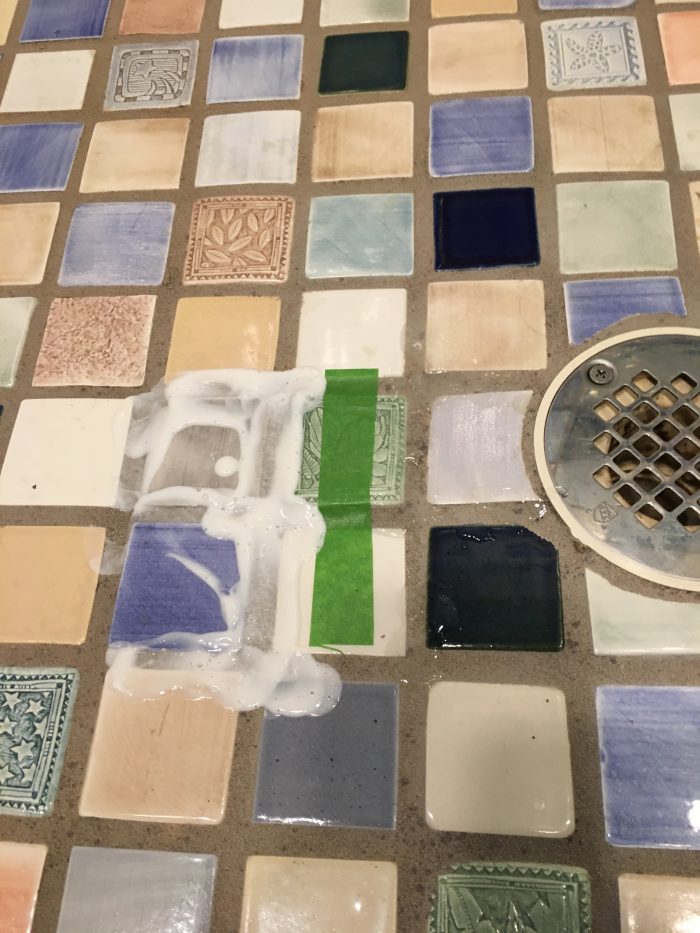
Shower floor scrubbed, wiped, rinsed, and dried:
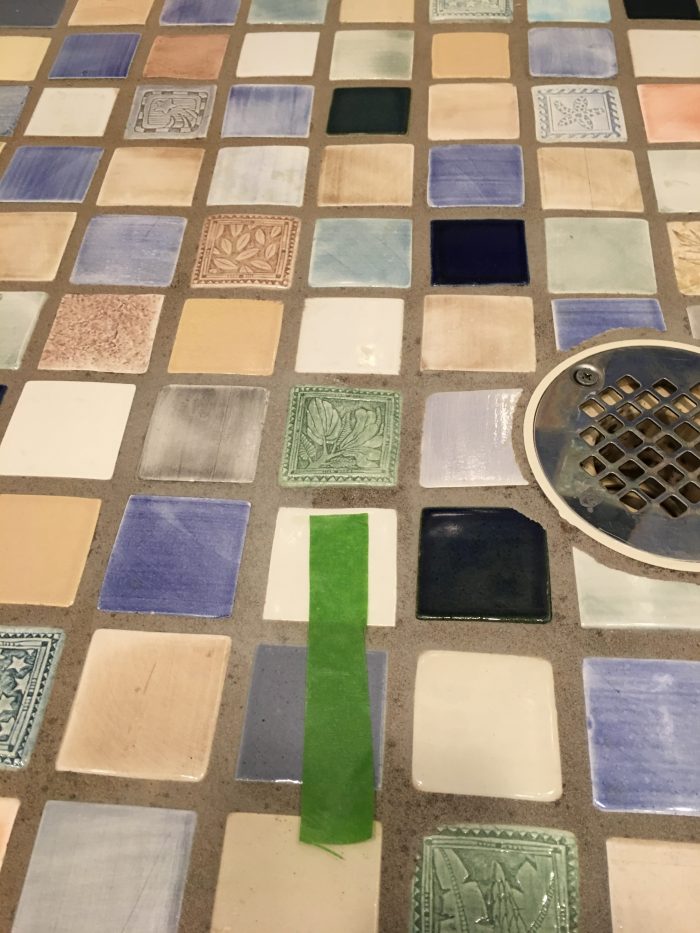
Polyurethane grout, all the way
I think the staining around the sink showed little improvement after each cleaner was used. The staining is modest and is somewhat better with either cleaner but probably permanently stained by food waste and water left too long in contact with the epoxy grout. On the other hand, one final look at the right side of the sink after scrubbing the whole counter with Soft Scrub shows pretty good results—not perfect, but certainly acceptable after more than 18 years in place. It could be that more “elbow grease” is as important if not more so than the type of cleaner used.

In the shower, the Soft Scrub on the polyurethane grout pretty much eliminated the black spots, doing a much better job than the OxyClean. And in general, after now more than 8 years, our polyurethane grout is in really good shape.
If I had to do any of this over again, I would use the Bostik QuartzLock2 polyurethane grout without hesitation. I wish I knew two more things:
- Why I found it so hard to find users of polyurethane tile grout.
- How other polyurethane grouts performed in comparison to Bostik’s.
Anyone tile setters out there care to weigh in?
-Peter Yost is GBA’s technical director. He is also the founder of a consulting company in Brattleboro, Vermont, called Building-Wright. He routinely consults on the design and construction of both new homes and retrofit projects. He has been building, researching, teaching, writing, and consulting on high-performance homes for more than twenty years, and he’s been recognized as NAHB Educator of the Year. Do you have a building science puzzle? Contact Pete here. Photos courtesy of the author.
AUTHOR’S UPDATE: Thursday, October 3
For nearly two weeks prior to posting this blog, I worked hard to engage Bostik technical support with questions I had about their polyurethane grout. I wish their technical support was as good as their grout, frankly. Here are the questions I emailed to two different technicians at Bostik that remain unanswered, but I am still working on it:
Weekly Newsletter
Get building science and energy efficiency advice, plus special offers, in your inbox.





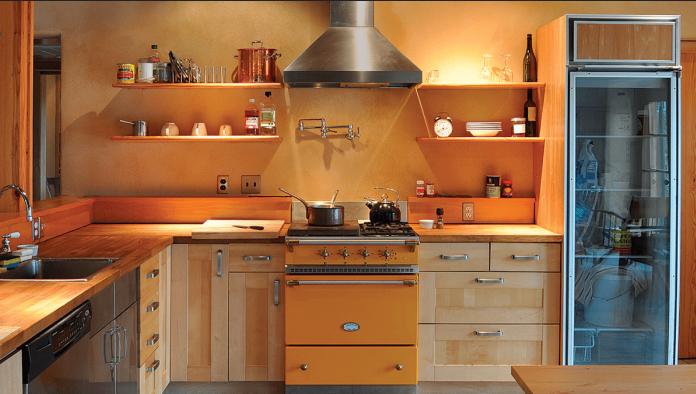
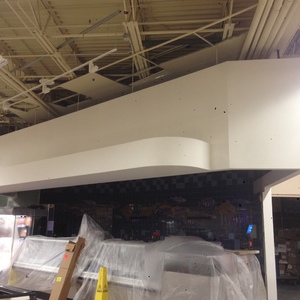






10 Comments
I've done a lot of tiling over the years. Only once did I try epoxy grout, and I won't do it again. Its just to0 unforgiving. Rather than looking for better grout, my approach has been to use tile in areas where the use doesn't stretch the capabilities of the materials (so no kitchen counters), use larger tiles (which limits the proportion of the surfaces that are vulnerable), and use very small grout lines (for the same reason). It also really helps to select rectified tiles.
I have been using epoxy grout for as long as I could get it. Lowes carried the Laticrete brand for a while, and then that disappeared (I am guessing, but I suspect that there were lots of complaints from people that did not read and follow the instructions).
When it came to finishing my new house, Lowes had a new epoxy grout called Stainmaster. It was great, but just as I was finishing up, it disappeared from the store.
Yes epoxy grout is a PITA to install, but regrouting, or cleaning conventional grout is even more so.
Between access to epoxy grout, I tried a stain proof grout from HD, with a name that I now forget. It was a pre-mixed product that was the worst thing that I even spread on tiles. As it cured, it shrunk, and I had to do the job again. It did not look right when done. Complete crap.
I am intrigued by the PU grout. Now, I need a project. Thank you for bringing this to light.
What are repairs like with polyurethane grout? I have no idea what it is like to work with the product, but I am thinking along the the lines of what is it like to replace a cracked tile and what is it like to redo all the grout? I have a bathroom floor to potentially redo at some point.
Your counter looks very good considering the age and application. Wiping such a surface clean is not nearly as easy any smooth surface.
The only repair I have done is to fill in a small void I discovered in a corner of a wall down low. The patch/fill was really easy; I just stirred up a small amount of leftover grout (I can't remember how long it was between the original job and the patch) and tooled it in.
Peter
Just finished our shower, and had our tile installer use epoxy grout, Spectralok Pro Premium to be exact. Even with all the potential improvements, epoxy grout is a PIA, even just watching the work being done. Mixing ratios are a pain, doing a half batch requires a good scale, and forget about doing a "touch up batch". Very short working time, cleaning is a royal pain, with limited time, and in our case insufficient cleaning detergents supplied (learned on second batch that second stage cleaner can be replaced by powdered dishwasher detergent).
I did not know about polyurethane grout at the time, much less that it was comparable in durability/cleanability. I will be using it on our next job, looks like it has most of the advantages of epoxy, with latex grout like mix flexibility and ease of haze clean up.
You mentioned epoxy grout remains flexible. Is this also true of PU grout? Traditionally any change of plane requires silicone caulk (the corner of two shower walls, or the joint between backsplash and counter, for example). I hate caulk in these areas and I'm wondering if I can get away with grout instead.
What's the issue with narrow grout lines using PU? Is it just harder to achieve, or a complete no-no?
Anyone done any testing of oil finishes over grout? Oil makes a great sealer and it's natural. Boiled linseed or Tung oil.
I'm also wondering what kind of flexural strength PU grout can achieve compared to epoxy grout. I make concrete furniture professionally and I think I might have to do some experiments. Epoxy concrete is a thing but it's kind of nasty stuff to work with.
Just a comment in case anyone else comes across this thread looking for the product - I believe that Bostik QuartzLock2 has been discontinued and replaced by 'TruColor RapidCure.'
I am sold on the (poly)urethane grout. The big problem is where the heck can I buy it? No retailer in my area (London, ON), be it box store or dedicated tiling store, has even heard of it. I left a message with Bostik Canada, so maybe they'll call back. I'm not holding my breath. I found a couple of pails on Amazon, but the colour selection is almost nil. edit: the only ones I can find are also the glass beaded ones, which I don't really want
Just a follow up, Bostik has two distributors in Canada. The one in the east is Crousset in Parc Colbert, QC. They do sell direct to end users and ship nation wide for reasonable prices. I didn't get the info on the other place.
I've been regrouting tile in the Atlanta area for 27 years and have used both poly and cement based grout many times.
Each type of grout has its pros and cons. Cement based grout will harden even with a little water present under the tiles, which is ideal for regrouting an older shower floor. Poly grout is great for a new shower, as it air dries, but will never harden if the subfloor beneath the tiles is even slightly wet. Cement grout requires water to cure, so is suitable for an older shower, as it absorbs any standing water.
But if I were installing a new tiled shower, I'd use the poly grout because it's waterproof and far more stain resistant. But it's also a looser grout with less bonding strength when applying, which means more grout falling on the floor when grouting walls.
Poly grout is also more sensitive to water and your sponge must be damp, but not too wet when cleaning excess grout. Too much water in the sponge will dissolve poly grout and leave you with shrunken grout lines. It's also important to wipe the excess with your sponge very lightly for the same reason.
Poly grout is also the ideal grout for outdoor tiled decks and patios, where hot and cold weather causes a lot of expansion and contraction with tiles. Cement grout is rigid and can't allow for expansion and contraction, leading to cracked grout and water problems underneath the tiles. Again, poly grout is waterproof, flexible enough to allow for expansion and contraction, and won't color fade in the sun.
But, as mentioned above, the tile and subfloor must be bone dry and can't get wet for the first 24 hours or it will wash out, both outdoors in the rain or the first time someone uses an older shower with moisture present under the shower floor.
Poly grout is also tricky to apply between hot tiles, like you'll find on a deck or patio on a warm, sunny day. It bakes onto a hot tile almost instantly, so it's critical to grout a very small area at a time in the sun and stop to clean the excess or you'll spend hours scraping it off with a flat razor blade.
Most tile installers hate poly grout for the above mentioned reasons, but it certainly has its advantages over cement based grout in certain applications, like decks and new showers. No grout is 100% stain proof, but poly is waterproof and far more stain resistant than cement grout.
Epoxy grout is really an epoxy glue with color added. It will still stain, but unlike poly and cement grouts, epoxy grout dries super hard and can't be removed, which means you can't regrout your shower, ever. Poly is just as waterproof and stain resistant as epoxy, but is soft enough to remove and regrout. You also don't have to hurry with the poly grout before it turns too hard to apply, which is another problem with epoxy grout.
After regrouting thousands of showers, the best tip I give my customers is to towel dry their newly regrouted shower after every use. That's the only way to keep your new grout looking new for many years, no matter what type of grout you use.
Log in or create an account to post a comment.
Sign up Log in